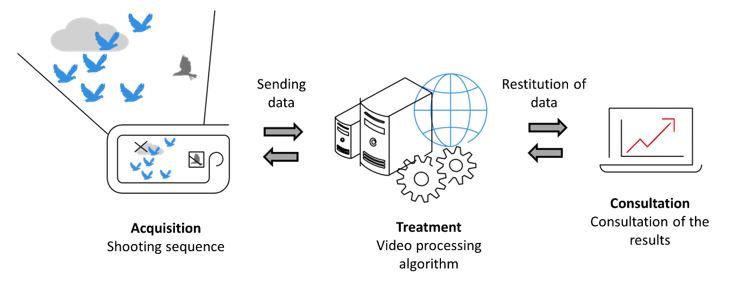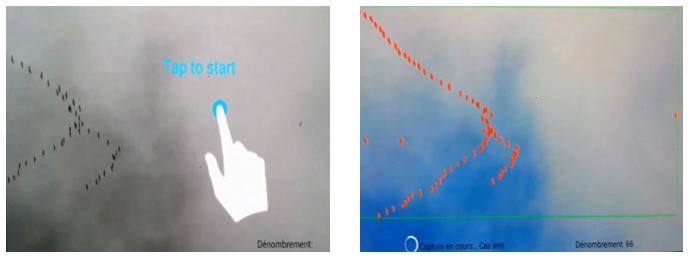Octobre Bleu is a research project led by Sogeti, the LaBRI (Bordeaux Computer Research Laboratory), the GIFS (Wildlife Investigation Group) and the financial support from region Nouvelle Aquitaine.
Its objective is to develop a tool for counting and recognising models from video data or images obtained with simple equipment (camera, smartphone, camera) whose characteristics will lead to the automatic adaptation of the operating mode. The challenge is to develop and offer a modular and configurable solution that can be adapted to any type of support and context.
The main use case of the project consists of the mapping of migratory birds (example of the Palombe, “Columba palumbus“, also called bluebird) in collaboration with the GIFS. The modus operandi consists of filming the pigeons in flight from a fixed or mobile camera (smartphone) and extracting the images of interest. This information is then sent to a central platform for automated processing and analysis: identification of the species, enumeration, related data (geographical coordinates, date, etc.).

Scientific synthesis
In an in-flight bird-counting application that is often very small in size (up to just a few pixels), conventional techniques for detecting moving objects based on object shape models or on detecting points of interest are largely unusable. Moreover, the differentiation between objects of interest (moving birds) and variations in the background of the scene (e.g. from moving and/or changing clouds, wind-driven vegetation movement, and camera movement) is a problem that must be taken into account to avoid many false detections.
In this context, the general principles of the counting methodology that has been developed are as follows:
- Introduction of an object of interest model: this model is based on the following descriptors :
– The size of the objects, which in theory should be the same for all birds (this assumes that the birds are all of the same species and that their distances from the camera are approximately the same for all).
– The colour of the objects. It is supposed to be the same for all birds (identical species), and to be given, in an approximate way, by the user.
– The movement and trajectory of the objects. Birds are assumed to be in motion and to follow a globally linear trajectory (at least over a limited time window).
– The group movement of birds: globally, migratory birds fly in groups, with therefore similar trajectories and speeds for each bird. - Intra-image analysis: the objective is to detect the birds in each successive image without taking into account the temporal dimension. The objective is to detect the vast majority of birds even if there are many false detections which will be later and for the most part eliminated by temporal filtering.
- Inter-image analysis: counting carried out image by image is likely to include many false detections. A temporal analysis of the detections obtained enables the detection of the majority of these false detections and the recovery of any missing detections. This temporal analysis is carried out by taking into account the trajectory and group movement model of the birds.
- Introduction of reliability criteria: the detection of very small moving objects makes it very likely that many false detections due to noise and very localised movements of the background of the scene will be detected and will prove to be relatively close to the object model. In addition, detection methods are often very sensitive to detection thresholds that are set empirically. To take this problem into account, reliability criteria are associated with each algorithmic phase. In the end, the counting is then carried out thanks to a sum weighted by these reliability coefficients.
The detection approach developed comprises two essential phases: an intra-image detection phase, followed by a temporal analysis.
Technical report
The technical part focused on the following 3 main projects:
- The mobile application allowing the capture, storage and pre-processing of videos, as well as their sending to the server platform. It provides useful video characterisation functions in order to refine the analysis processing.
- The server architecture consisting of the communication with the capture media, the storage of captured videos, the launch of processing, the availability of results on a dedicated website.
- All the algorithms and services necessary for video processing, available in the form of packages.
Continuous work on improving and optimising the algorithms was necessary throughout the project, particularly for the run-of-river test and the improvement of the algorithms developed, and in order to obtain satisfactory processing times. The analysis of the different stages of the algorithms made it possible to adapt the parameters used to the shooting conditions, such as the minimum visibility threshold of objects far from the camera, the size and the theoretical colour of the object model.

Conclusion
On a scientific level, the work carried out during this project has made it possible to develop an original method for detecting and spatio-temporal counting of very small objects in a video with a specific application to the counting of migratory birds. They have shown the relevance of introducing reliability coefficients in the counting procedure by allowing a very strong reduction of false detections, which is an original aspect of this work. These coefficients are made necessary by the difficulty of differentiating very small objects in videos against a textured or noisy image background.
The outlook for this work is mainly as follows:
- In the short term, this will be :
- Better optimising cooperation between the spatial and temporal analysis phases to better optimise the phase of eliminating false detections
- To test the method for the detection of other types of very small objects in videos
- To rationalise the use of detection thresholds so as to further limit their influence on counting results
- In the longer term, it is a question of generalising the notion of reliability criteria to other object detection contexts, particularly in the field of vision and obstacle detection.
As things stand, the results obtained do not allow us to envisage the industrialisation of the solution with a view to marketing it as initially expected.
However, the project has led to the production of a lighter version of the solution on a mobile phone used by GIFS in the context of counting campaigns as well as for training and calibration of manual counts.
Throughout the project, Sogeti has been able to offer permanent contracts to young engineers.

 English | EN
English | EN 